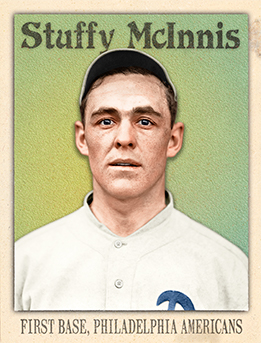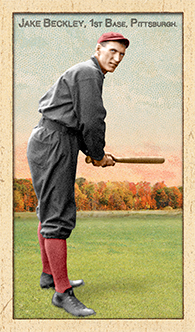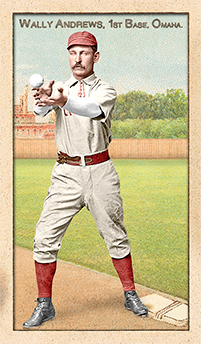- Series: Beginnings: 1880's
- City: Pittsburgh
- Team: Alleghenys
- League: National League
- Hall: National Baseball Hall of Fame
Jacob Peter Beckley (1867-1918) was a durable first-baseman over a 20-year career. Though he never played for a pennant winner, Beckley hit .309 lifetime and held the games-played-at-first record until Eddie Murray surpassed him in 1994. Hit .300+ in 13 seasons (three different Pittsburgh clubs, Giants, Reds and Cards). Upon his retirement, Beckley’s 2,930 career hits placed him second only to Cap Anson.
- Not above subterfuge, worked a hidden-ball trick on Honus Wagner using two balls
- Known for cheating on the base paths, was called out by the ump for “getting there too fast!” after racing from 2nd directly home while Blue wasn’t looking
- Elected to Hall of Fame: 1971
- Series: Beginnings: 1880's
- City: Chicago
- Team: White Stockings
- League: National League
- Hall: National Baseball Hall of Fame
Adrian Constantine Anson (1852-1922) was Mr. Longevity, a big, brawling cyclone of controversy & batsmanship unrivaled in the early days of pro ball. He set hitting standards that only the greatest future players would approach or break. He also, by dint of his ferocious personality, may have been the single greatest force for segregation in baseball until Branch Rickey began to reverse that sad estate.
- Played a record 27 consecutive years in the NL
- First batter to 3000 hits, using his powerful arms to create line drives with a short swing
- Managed the Chicago NL team to five pennants and still holds the Cub franchise records for hits, doubles, runs scored and runs batted in
- Elected to Hall of Fame: 1939
- Series: Beginnings: 1880's
- City: Omaha
- Team: Omahogs
- League: Western Association
William Walter Andrews (1859-1940) played for the Louisville franchise of the American Association which lasted ten years under two identities, both of which employed Andrews. Wally debuted with the Eclipse in May of 1884 as a right-handed first baseman and utility player. He got into 14 games that season and hit a meager .204. He played in the minors for awhile and had a bang-up year for the Memphis Browns in 1887 where he hit .422 and 28 HRs. Not surprisingly, Louisville gave him another look. By 1888, the team was the Colonels and Andrews, now age 29, got into 26 games where he fared a bit poorer than his first stint, managing a .194 average in 93 at-bats. He did yeoman service defensively, however, making only a single error in 294 chances for a .997 fldg %.
- Born on the eve of the Civil War in Philadelphia, Andrews died in Indianapolis just as World War II raged in Europe, on January 20, 1940

- Series: Diamond Heads '15
- City: St. Louis
- Team: Cardinals
- League: National League
John Barney Miller (1886-1923) broke into major league ball in 1909 at the top of the game. As second-baseman for the Pirates, Dots would spend his rookie season with a champion as Pittsburgh won the NL pennant and beat the Tigers in the World Series. Miller went on to a fine 12-year career with three National League clubs: five with Pittsburgh, five with the Cardinals and the last two with the Phillies. When Fred Clarke brought Miller to the ‘09 spring camp he played him at short as the team’s regular, a guy named Honus Wagner, was late arriving. There was no way Miller would stay at that position once Wagner finally showed up but his play impressed Clarke enough to earn a spot at 2nd. A reporter asked Wagner who the new kid was and Hans said “That’s Miller.” The scribe noted it phonetically and a memorable nickname was born. Dots became a versatile addition to each team, playing every position for St Louis and prompting Ring Lardner to dub him the best utility man of the era.
- Miller succumbed to TB just as his promising managerial career was beginning. He led his San Francisco Seals to the PCL pennant in 1922
- NL president John Heydler paid tribute to “a brainy player, well liked everywhere…”

- Series: Diamond Heads '15
- City: Philadelphia
- Team: Athletics (AL)
- League: American League
John Phalen McInnis (1890-1960) helped five teams to world championships as a stellar first baseman. He broke in with the Athletics in 1909 and soon became part of the elite “$100,000 Infield” with Eddie Collins, Frank Baker and Jack Barry. That team won four AL pennants in five years with three titles before losing to the Miracle Braves in their incredible 1914 sweep. Federal League incursions prompted Connie Mack to break up his famed nine but kept Stuffy through the 1917 season. A great batting eye made McInnis one of the toughest to fan (he struck out a mere 189 times in 7822 career at-bats.) and he compiled a .307 lifetime average. Equally adept afield, Stuffy was a perennial defensive leader at first. In 1921 he made one error in 1651 attempts. His Red Sox record was not exceeded until Kevin Youkilis played 120 error-free games in 2007. McInnis would play for the Indians, Braves, Pirates and Phillies, wrapping his long and distinguished career as player-manager in Philadelphia in 1927.
- His skill at the plate enabled McInnis to accomplish 384 sacrifice hits, the third-best in MLB history
- After his career in the majors, Stuffy coached college squads ending with the Harvard Crimson from 1949-54




